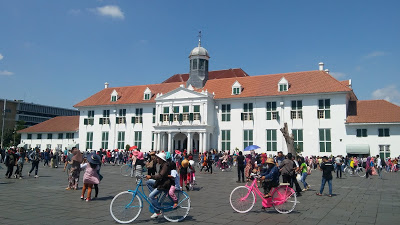Door Christopher Joby

When speakers of one language encounter those of another, they often insert words of the other language into their own. This is called code switching. They may do this for a number of reasons. One of these is that they lack a word to describe a new thing or idea they encounter or because the new language has more prestige than their own. When the Dutch began trading with people in East Asia, they encountered many new things, such as goods, types of ship, coins and units of measure, to name but a few. The Dutch were prodigious record keepers, noting down almost everything that happened at their trading posts on Java, in Taiwan, on Kyushu, Japan and elsewhere in dagregisters, or factory journals. These facts mean that the Dutch language in these journals is full of code switching. A recent project on the factory journals kept at Batavia, the centre of Dutch trading activities in the East Indies, gives a sense of the number of non-Dutch words inserted into the Dutch texts.
In one or two cases, the words are of Portuguese origin, such as pancado, a fixed price for raw silk. There are also Arabic and Persian words. The Arabic coin کبير (from the Arabic for ‘big’) and Persian gīlān ( گيلان ), a type of silk, are two examples, reminding us that the Dutch trading network spread to the Middle East. From the Indonesian archipelago we find words such as the Malay gantang, a unit of weight, and the Javanese demang, a district chief.
Several forms of Chinese are used in Dutch texts. The Mandarin huáng chuán (艎舡), a type of ship, is often given in a Malay form, wankang. Cantonese is represented with sum, a type of ginseng and Hokkein with the word for ’tea’ tê (茶), which has given rise to most European words for tea, with a couple of exceptions such as Portuguese chá (from Mandarin) and Polish herbata. Japanese coins such as the ichibu (分) are mentioned in the Dutch records and Hindi words such as kāch (काछ), a type of cloth are also used in cases of code switching.
Tough the vocabulary is very different from that being used in the Low Countries. We might call this form of Dutch used in East Asia a regiolect, or thalassolect (sea language) or perhaps emporiolect (a trading language). However, whatever we call it, what the above underlines is the diversity of the history of Dutch. In this regard, it may be better to talk, along with Peter Burke, of Dutches than one Dutch language.
Further reading
Lohanda, Mona, et al., VOC Glossary Indonesia, Published Version 1.0 on February, 6th 2018.
Dit stukje verscheen eerder op The History of Dutch
Dit is een interessant artikel. Op het moment bestudeer ik de reis van Lemaire en Schouten, waarbij zij Kaap Hoorn op de kaart hebben gezet. Lemaire heeft een polynesische woordenlijst samengesteld, die op het moment tentoongesteld wordt in het koninkrijk Tonga, als oudste voorbeeld van geschreven Tongaans. Binnekort verschijnt er een artikeltje in het Kaap Hoornjournaal over Nederlandse leenwoorden in de Polynesische talen. Enkele leenwoorden zijn met hoge waarschijnlijkheid te herleiden tot Lemaire en anderen tot Tasman en Roggeveen, Nederlandse ontdekkingsreizigers. De Engelse en Franse ontdekkingsreizigers verschenen ruim een eeuw later dan de Nederlandse in de Grote Oceaan. Er zou meer studie gedaan moeten worden naar Nederlandse leenwoorden in het gebied van de Grote en de Indische Oceaan, b.v. In Japan, Korea, India en Sri Lanka, Indonesië, China, Taiwan. Van de leenwoorden in het Nederlands is al veel bekend. Ik zie al een reeks scripties voor me en een aantal proefschriften.